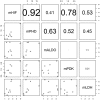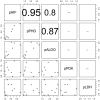The physiological and molecular response of Aurelia sp.1 under hypoxia
- PMID: 28484259
- PMCID: PMC5431473
- DOI: 10.1038/s41598-017-01318-x
The physiological and molecular response of Aurelia sp.1 under hypoxia
Abstract
Few studies have been published on the mechanisms of hypoxia response and tolerance in jellyfish, especially with respect to the regulatory mechanism at the molecular level. In this study, Aurelia sp.1, which is frequently found in Chinese coastal waters, was cultivated in a hypoxic system to determine the molecular mechanisms underlying its hypoxic response by studying the physiological activity, gene expression and metabolite contents in the prolyl hydroxylase domain (PHD)-hypoxia inducible factor (HIF) oxygen-sensing system. Physiological activity; the expression of PHD, HIF, ALDO (fructose-bisphosphate aldolase), PDK (pyruvate dehydrogenase kinase), and LDH (lactate dehydrogenase) genes; and the lactic acid content in medusae were significantly affected by hypoxia. The up-regulation of ALDO, PDK and LDH, which was directly or indirectly induced by HIF, mediated the transition from aerobic respiration to anaerobic glycolysis in the medusae. In polyps, there was a slight increase in the expression of HIF, PHD and ALDO, no obvious change in that of PDK and a slight decrease in that of LDH throughout the experiment; however, these changes were insufficient to induce the shift. This study provides a scientific basis for elucidating the regulatory mechanism underlying the PHD-HIF oxygen-sensing system in Aurelia sp.1.
Conflict of interest statement
The authors declare that they have no competing interests.
Figures











Similar articles
-
Molecular characterisation, evolution and expression of hypoxia-inducible factor in Aurelia sp.1.PLoS One. 2014 Jun 13;9(6):e100057. doi: 10.1371/journal.pone.0100057. eCollection 2014. PLoS One. 2014. PMID: 24926666 Free PMC article.
-
Life Cycle Reversal in Aurelia sp.1 (Cnidaria, Scyphozoa).PLoS One. 2015 Dec 21;10(12):e0145314. doi: 10.1371/journal.pone.0145314. eCollection 2015. PLoS One. 2015. PMID: 26690755 Free PMC article.
-
β-N-oxalyl-L-α, β- diaminopropionic acid induces HRE expression by inhibiting HIF-prolyl hydroxylase-2 in normoxic conditions.Eur J Pharmacol. 2016 Nov 15;791:405-411. doi: 10.1016/j.ejphar.2016.07.007. Epub 2016 Jul 5. Eur J Pharmacol. 2016. PMID: 27393459
-
Cellular oxygen sensing need in CNS function: physiological and pathological implications.J Exp Biol. 2004 Aug;207(Pt 18):3171-88. doi: 10.1242/jeb.01075. J Exp Biol. 2004. PMID: 15299039 Review.
-
Cellular signal transduction of the hypoxia response.J Biochem. 2009 Dec;146(6):757-65. doi: 10.1093/jb/mvp167. Epub 2009 Oct 28. J Biochem. 2009. PMID: 19864435 Review.
Cited by
-
The branched mitochondrial respiratory chain from the jellyfish Stomolophus sp2 as a probable adaptive response to environmental changes.J Bioenerg Biomembr. 2024 Apr;56(2):101-115. doi: 10.1007/s10863-023-09999-y. Epub 2024 Jan 17. J Bioenerg Biomembr. 2024. PMID: 38231368
-
Regeneration Potential of Jellyfish: Cellular Mechanisms and Molecular Insights.Genes (Basel). 2021 May 17;12(5):758. doi: 10.3390/genes12050758. Genes (Basel). 2021. PMID: 34067753 Free PMC article. Review.
-
Hypoxia disrupts metabolism in coral and sea anemone larvae.J Exp Biol. 2025 Jun 15;228(12):jeb250372. doi: 10.1242/jeb.250372. Epub 2025 Jun 27. J Exp Biol. 2025. PMID: 40452587 Free PMC article.
References
-
- Graham WM. Numerical increases and distributional shifts of Chrysaora quinquecirrha, (Desor) and Aurelia aurita, (Linné) (Cnidaria: Scyphozoa) in the northern Gulf of Mexico. Hydrobiologia. 2001;451:97–111. doi: 10.1023/A:1011844208119. - DOI
-
- Shoji J, Kudoh T, Takatsuji H, Kawaguchi O, Kasai A. Distribution of moon jellyfish Aurelia aurita in relation to summer hypoxia in Hiroshima Bay, Seto Inland Sea. Estuar Coast Shelf S. 2010;86:485–490. doi: 10.1016/j.ecss.2009.03.001. - DOI
-
- Ki J-S, et al. Recent moon jelly (Aurelia sp.1) blooms in Korean coastal waters suggest global expansion: examples inferred from mitochondrial COI and nuclear ITS-5.8S rDNA sequences. Ices J Mar Sci. 2008;65:443–452. doi: 10.1093/icesjms/fsn018. - DOI
-
- Shoji J, Masuda R, Yamashita Y, Tanaka M. Effect of low dissolved oxygen concentrations on behavior and predation rates on red sea bream Pagrus major larvae by the jellyfish Aurelia aurita and by juvenile Spanish mackerel Scomberomorus niphonius. Mar Biol. 2005;147:863–868. doi: 10.1007/s00227-005-1579-8. - DOI
-
- Shoji J, Masuda R, Yamashita Y, Tanaka M. Predation on fish larvae by moon jellyfish Aurelia aurita under low dissolved oxygen concentrations. Fisheries Sci. 2005;71:748–753. doi: 10.1111/j.1444-2906.2005.01024.x. - DOI
Publication types
MeSH terms
Substances
LinkOut - more resources
Full Text Sources
Other Literature Sources

